Land Use Strategy (LUS) Delivery Evaluation Project - Volume 1: Main Report
This report provides the fundings of the Land Use Strategy Delivery Evaluation Project undertaken in Scotland between 2012 and 2014. It evaluates eleven case study land use delivery mechanisms to ascertain their effectiveness in translating the strategic Principles of the LUS into decision-making on the ground.
3 Translating the LUS Principles into action on the ground
3.1 Research Question No.1 asks "have the high level LUS Principles been (implicitly or explicitly) translated into decision-making on the ground and, if they have, how well?" The response to this question provides the basis for responding to all other Research Questions and is of fundamental importance to the overall findings.
3.2 This Chapter includes a summary of the analysis approach used for the Research Question No.1 evaluation, an overall summary of the evaluation, case study specific evaluation summaries and a synthesis of key themes/issues emerging from the Research Question No.1 evaluation. Detailed case study specific Research Question No.1 evaluations are provided in Appendix 4.
Analysis approach
3.3 As discussed in Chapter 2, it has been necessary to define what is meant by 'on the ground' for each of the case studies, recognising that the scope of the LUS Delivery Evaluation Project is such that most of the case studies will not reach a decision-making juncture leading to tangible land use/management impacts in the landscape (see Table 2.4). Rather, the focus of this project is on policy and process level decision-making.
3.4 As such, the collation of data to support the Research Question No.1 evaluation has focussed on the specific 'on the ground' decision-making juncture defined for each case study (see Table 2.4). In practice this involved document review in the first instance to identify documented evidence of LUS Principle consideration. This was then validated through semi-structured interviews with case study leads and other stakeholders as appropriate.
3.5 The Research Question No.1 evaluation considered both process and outcome issues supported by the bespoke evaluation criteria detailed at Appendix 1. Consideration of LUS Principles in terms of process reflects the context within which decisions are made. Consideration of outcome reflects the results of decision-making. Where a Principle has been considered comprehensively in relation to both process and outcome issues, it is said to have been translated into decision-making 'on the ground'. LUS Principle B on regulation was a special case in terms of Research Question No.1 evaluation as described further at paragraph 3.10 onwards.
3.6 In the case of the CSGN for example (see Tables 2.3 and 2.4 and Figure 2.4), data collation around process focussed on assessing where the LUS Principles were considered in the CSGN's strategic policy framework (the Vision and Work Plan documents) and the formal Development Fund application process. Data collation around outcome focussed on a sample of Development Fund supported projects. In this manner, it was possible to evaluate the degree to which LUS Principles considered within the CSGN strategic policy framework have been translated into Development Fund award decision-making (recognising that the evaluation only considered a sample of Development Fund supported projects).
3.7 The Research Question No.1 evaluation was informed by: 1) evidence on consideration of LUS Principles in terms of process/outcome; and 2) the bespoke evaluation criteria designed to help the research team identify where LUS Principles were being considered/translated (see Chapter 2 paragraph 2.38 and Appendix 1). The use of criteria in this regard facilitated the assessment of "how well have the LUS Principles been translated" i.e. by taking a view on the degree to which the case studies have met all or some of the criteria, supported by the evidence. A four point scale was used as follows:
- Principle translated - yes
- Principle translated to a degree
- Principle not translated - no
- N/A - principle not relevant[9]
3.8 This evaluation approach reflects practical land use/management policy decision-making inasmuch as consideration of LUS Principles or LUS Principle type issues at the policy level may be relatively comprehensive (i.e. evaluation of process) yet there is scope for this strong consideration to be diluted through subsequent decision-making (i.e. evaluation of outcome).
3.9 This is a particular issue for this research given that, within the timescales of the project (April 2012 - April 2014), few of the case studies have reached a decision-making juncture that has led to tangible land use/management impacts in the landscape. In this regard, there is scope for further dilution of the LUS Principles before they actively influence a practical land use/management decision 'on the ground'.
The specific case of LUS Principle B
3.10 The evaluation of LUS Principle B on regulation in terms of translation 'on the ground' raised specific challenges due to the nature and scope of the Principle. In terms of the Principle itself, the focus is very much on doing 'good regulation' i.e. ensuring that public interest is protected whilst minimising the burden on business in the development of new or revision of existing regulation.
3.11 Conversely, LUS Principle B related proposals within the LUS Action Plan (Scottish Government, 2011b) are more concerned with the wholesale integration of all LUS Principles within relevant regulation and incentives e.g. Common Agricultural Policy (CAP) reform, guidance on local flood risk management (FRM) strategies and planning and other development consent regimes more generally.
3.12 In this regard, another possible route for translating LUS Principle B relates to the general integration/embedding of all LUS Principles within existing regulation and incentives. This route may be a possibility in particular for public authority type land use delivery mechanisms that are implementing some higher level legislation/regulation at a lower level - e.g. a Local Development Plan (LDP) implementing the Planning etc (Scotland) Act 2006.
3.13 To inform the Research Question No.1 evaluation of LUS Principle B the research has defined four key 'routes' by which the Principle can be translated into decision-making 'on the ground'. Where none of these routes are relevant, LUS Principle B is deemed to be non-applicable for the case study in question. The four routes are:
- 1. Introduction of new regulation/incentives with measures to support compliance i.e. helping to minimise the burden of regulation
- 2. Revision of existing regulation/incentives with measures to support compliance i.e. helping to minimise the burden of regulation
- 3. Doing something different or new that somehow streamlines or supports the delivery of existing regulation - note that this is different from route No.2 as it is separate from the regulation. In particular, route No.3 is regarded as providing private sector land use delivery mechanisms with an opportunity to translate LUS Principle B
- 4. For public sector land use delivery mechanisms that are implementing some higher level legislation/regulation at a lower level (e.g. LDPs, FRM strategies, RBMPs etc) - the integration of wider LUS Principles within the lower level regulatory framework/regime
Translating LUS Principles on the ground - overall summary
3.14 The LUS Delivery Evaluation Project has considered eleven case study land use delivery mechanisms. This represents a small sample from the wider Scottish land use delivery mechanism landscape (see Chapter 1 paragraph 1.19 and Table 1.2). Furthermore, the scope of the evaluation for each case study has necessarily focussed on a specific decision-making juncture that has been construed as 'on the ground' for the purposes of this research (see Chapter 2 paragraph 2.28 onwards and Table 2.4).
3.15 As such, the evaluation represents a snapshot of Scottish land use delivery or indeed individual case study land use delivery - i.e. the findings outlined here cannot be construed as fully representative of land use delivery in Scotland or in the case studies for that matter. For example, different case studies or case study foci might have yielded different results and the findings should be read with this in mind.
3.16 Overall, the Research Question No.1 evaluation indicates that in a narrow majority (57 of 110 instances[10]) the LUS Principles have been translated into decision-making 'on the ground'. In a substantial number of instances (42 out of 110) the Principles have been translated to a degree whilst instances of the Principles not being translated (4 out of 110) or not being relevant (7 out of 110) are much less frequent. This is indicated on Figure 3.1.
3.17 Overall therefore, the LUS Principles have been considered at least to a degree in the majority of instances (99 out of 110) within the case study sample considered. For the most part, the consideration of LUS Principles has been implicit rather than explicit - i.e. consideration of LUS Principles in decision-making has been teased out using the evaluation criteria as described above at paragraph 3.3 onwards. A visual summary of the Research Question No.1 evaluation overall is shown at Figure 3.4.
![Figure 3.1 Degree to which all 10 LUS Principles have been translated into decision-making 'on the ground' - number of instances[11] across all case studies Figure 3.1 Degree to which all 10 LUS Principles have been translated into decision-making 'on the ground' - number of instances[11] across all case studies](/binaries/content/gallery/publications/research-analysis/2014/05/land-use-strategy-lus-delivery-evaluation-project-volume-1-main-report/00451160.gif)
Figure 3.1 Degree to which all 10 LUS Principles have been translated into decision-making 'on the ground' - number of instances[11] across all case studies
- For the two case studies that did not reach their specific 'on the ground' decision-making juncture during the lifetime of the LUS Delivery Evaluation Project (the Glasgow LDP and the two FWS - see Table 2.4), the Figure above includes Research Question No.1 process issue data only (see paragraphs 3.3 - 3.9 and Appendix 1 as well). This is for the purposes of illustration
3.18 Figure 3.2 shows the results of the Research Question No.1 evaluation on the basis of individual LUS Principles. The data indicates relatively consistent translation across the following six LUS Principles: Principle A on multiple benefits, C on primary use, D on ecosystem services, E on landscape change, I on involving people and J on land use and the daily living link.
3.19 In all except one of these cases a majority (between six and seven) of the eleven case studies have translated the Principle into decision-making 'on the ground' with a smaller portion (between three and four) only translating the Principle to a degree. The exception is LUS Principle I on involving people where one case study did not consider/translate the Principle.
3.20 The translation of other LUS Principles was found to be more mixed - Principle B on regulation, G on vacant and derelict land and H on outdoor recreation and access. Translation of Principle G in particular was found to be particularly mixed with two of the case studies having translated it into decision-making 'on the ground', three to a degree and two not translating it. Importantly, LUS Principle G was found to not be relevant to four of the case studies. The potential reasons for this are discussed in the case study specific sections later on in this Chapter (paragraph 3.23 onwards).
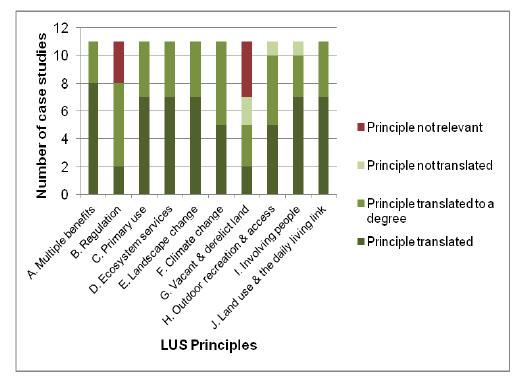
Figure 3.2 Degree to which individual LUS Principles have been translated into decision-making 'on the ground' - percentage of instances across all case studies
- For the two case studies that did not reach their specific 'on the ground' decision-making juncture during the lifetime of the LUS Delivery Evaluation Project (the Glasgow LDP and the two FWS - see Table 2.4), the Figure above includes Research Question No.1 process issue data only (see paragraphs 3.3 - 3.9 and Appendix 1 as well). This is for the purposes of illustration
3.21 Crucially for the LUS given its provenance within Scotland's climate change legislation, translation of LUS Principle F on climate change was relatively poorly represented in the sense that a small majority of case studies (six) only translated it to a degree with a small minority (five) translating it fully. This is in marked contrast to LUS Principles A, C, D, E, I and J where the majority of case studies translated the Principle fully.
3.22 As discussed further in relevant case study specific sections of this Chapter, one key reason for this is LUS Principle F's dual focus on climate change mitigation and adaptation, a factor that has been reflected in the Research Question No.1 evaluation criteria (see Appendix 1). In some instances, case studies have only considered mitigation or adaptation actions rather than both whereas the LUS (and indeed other policy and literature on climate change) suggests that there should be scope for practical land use/management to deliver against both agendas, in most (if not all) cases. In these instances therefore, case studies were assessed as having only partially translated LUS Principle F i.e. translation 'to a degree' (see paragraph 3.7).
Translating LUS Principles on the ground - case study specific summaries
3.23 An overall summary of the Research Question No.1 evaluation is provided at paragraphs 3.14 - 3.22 above. This section provides case study specific summaries including visual summaries of the degree to which individual case studies have translated the ten LUS Principles into decision-making 'on the ground' and an analysis and commentary on significant issues, framed in terms of relevant sub-Research Questions.
3.24 Detailed, case study specific Research Question No.1 evaluation assessment tables can be found at Appendix 4 and should be read in conjunction with the summaries documented here. Appendix 4 also provides a description of the data that has been used to support the Research Question No.1 evaluation for each case study.
Buccleuch Estates Whole Estates Development Plan (WEDP) approach
3.25 As outlined at table 2.4, 'on the ground' in the context of the Buccleuch Estates WEDP approach has been interpreted as: the application and interpretation of the WEDP approach to specific estates i.e. the degree to which the LUS Principles have been incorporated within the WEDP approach and then translated into decision-making at the estate level.
3.26 The Buccleuch Estates 'on the ground' decision-making juncture has been met during the course of the LUS Delivery Evaluation Project and has been considered fully in the Research Question No.1 evaluation. More detailed information on the Buccleuch Estates 'on the ground' decision-making juncture is provided at Appendix 4 (paragraph 4.1 onwards) along with the detailed evaluation which includes an explanation of the rationale for each assessment. Figure 3.3 provides a summary of the Research Question No.1 evaluation.
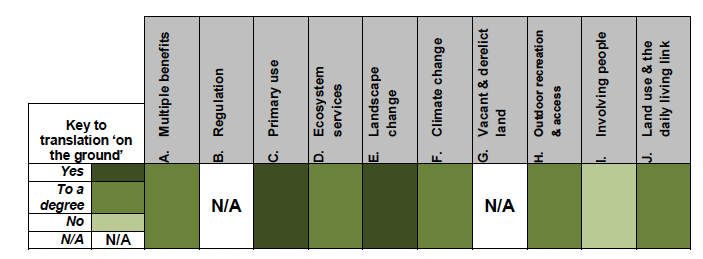
Figure 3.3 Buccleuch Estates WEDP approach - summary of Research Question No.1 evaluation: translation of LUS Principles into decision-making 'on the ground'
3.27 Two of the LUS Principles have been translated fully, five to a degree, one hasn't been translated at all and two Principles are deemed to be non-applicable to the specific context. There was no explicit mention of the LUS or the LUS Principles within the documents reviewed so all consideration of the Principles is implicit rather than explicit. Interestingly the WEDP Pilot Project Report includes a specific mention of the LUS ecosystems approach information note (Scottish Government, 2011c) but no mention of the LUS itself.
3.28 The two LUS Principles deemed to be non-applicable in the Buccleuch Estates context are Principle B on regulation and G on vacant and derelict land. In terms of Principle B, the only route that would be available to the Buccleuch Estates case study is route No.3 - i.e. doing something different or new that somehow streamlines or supports the delivery of existing regulation (see paragraph 3.10 for further information).
3.29 Whilst the WEDP approach is, itself, a novel approach with the potential to help streamline or support regulation (e.g. collating and presenting land use/management data in a consistent and integrated format), this did not come across in the data or the evaluation. In terms of Principle G, vacant and derelict land is not a significant land management issue for Buccleuch Estates and it is therefore not considered in the WEDP approach.
3.30 LUS Principle C on primary use and E on landscape change were both considered to have been translated fully. In terms of Principle C, the highly spatial nature of the WEDP approach lends itself to the use and analysis of spatial data in order to map key areas of primary use including forestry, in-hand farming (arable and pasture ground) and also the 'core heritage estate' - i.e. parts of the estate where the landscape has a particularly significant socio-cultural value. A lack of understanding, data and incentives around flood/water management and the management of peat/carbon rich soils may mean that these potential primary land uses are accounted for less comprehensively in the WEDP spatial analysis.
3.31 LUS Principle I on involving people is considered to have not been translated. Engagement with local communities is felt to be relevant when considering specific land use/management changes[12] but there are currently no plans to involve the public/affected communities in decision-making at the whole estate level. As a private land owner however, Buccleuch Estates are under no obligation to consult the public on estate-wide land use/management plans and policy
Central Scotland Green Network (CSGN)
3.32 As outlined at Table 2.4, 'on the ground' in the context of the CSGN has been interpreted as: the process of deciding which applicant projects to award CSGN Development Fund monies to i.e. the degree to which the LUS Principles have informed the translation of CSGN strategic policy into Development Fund award decision-making. The specific case of the CSGN in this regard is outlined further as an example in Chapter 2 and depicted on Figure 2.4.
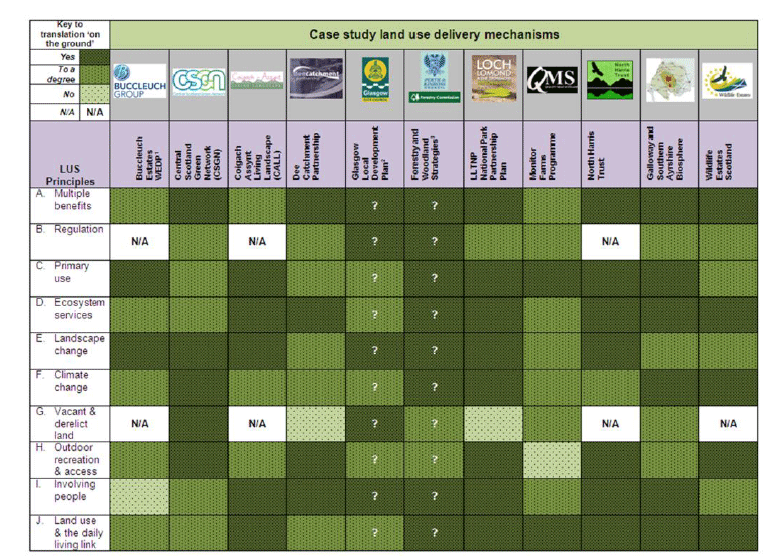
Figure 3.4 Visual summary of Research Question No.1 evaluation - translation of LUS Principles into decision-making on the ground
- As per Table 2.4, the Glasgow LDP case study and the two FWS case studies (Stirling and Clackmannanshire/Perth and Kinross) did not meet their 'on the ground' decision-making juncture during the project. Accordingly, the Research Question No.1 evaluation for these two case studies is based on process issue data only
- In these instances therefore the evaluation is only an estimate of translation 'on the ground' - i.e. had outcome issue data been available as well it may have been apparent, for example, that some of the LUS Principles have not been translated from their consideration at the policy/decision-making level into action 'on the ground' (i.e. Supplementary Guidance on green network in the case of the Glasgow LDP and adopted strategies in the case of the two FWS). This is indicated by a ? on the Figure
3.33 The CSGN 'on the ground' decision-making juncture has been met during the course of the LUS Delivery Evaluation Project and has been considered fully in the Research Question No.1 evaluation. More detailed information on the CSGN 'on the ground' decision-making juncture is provided at Appendix 4 (paragraph 4.7 onwards) along with the detailed evaluation which includes an explanation of the rationale for each assessment. Figure 3.5 provides a summary of the Research Question No.1 evaluation for the CSGN case study.
3.34 Five of the LUS Principles have been translated fully and five to a degree. Accordingly, all ten Principles are considered to be relevant to the CSGN case study. There is one explicit mention of the LUS in the CSGN Work Plan 2012-2015 but no explicit mention of the LUS Principles themselves. As such, all consideration of the Principles is implicit rather than explicit.
3.35 LUS Principle A on multiple benefits, E on landscape change, F on climate change, G on vacant and derelict land and H on outdoor recreation and access were considered to have been translated fully. In terms of Principle E for example, the CSGN consider landscape planning and management issues at a range of scales including from "towns and cities [to] the wider countryside and coast" (CSGN Partnership Board, 2011a p.5). Crucially, landscape issues at a more human scale are also reflected in relation to the role of environmental settings influencing sense of place and human wellbeing.
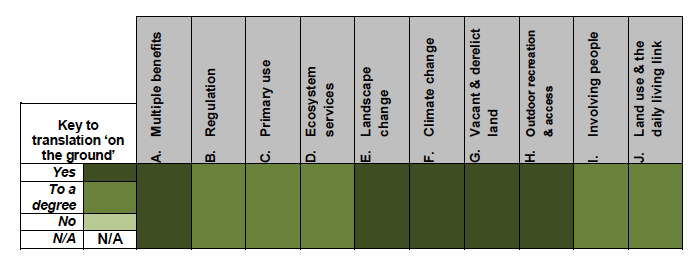
Figure 3.5 CSGN - summary of Research Question No.1 evaluation: translation of LUS Principles into decision-making 'on the ground'
3.36 LUS Principle G and vacant and derelict land (VDL) issues are a particular priority for the CSGN given the region's legacy of industrial dereliction. In this regard, VDL objectives are prevalent throughout all elements of the CSGN's strategic framework (Vision and Work Plan) and have been a named priority within the CSGN Development Fund application process since its inception. The CSGN Work Plan 2012-2015 includes specific measures on the integration of VDL with relevant Scottish Government policies and funding streams. Crucially, three of the nine Development Fund supported projects considered in the evaluation had addressed VDL issues in detail including opportunities for the delivery of multiple benefits from VDL sites (e.g. habitat networks, biodiversity enhancement, community food growing, access and active travel, health and wellbeing and placemaking) demonstrating the potentially important links between LUS Principle G and other Principles.
3.37 In terms of LUS Principles that were considered less well in the CSGN case study, LUS Principle I on involving people is of noteworthy importance. The CSGN Vision was subject to public consultation and includes important provisions in this regard such as "communities should be at the heart of decision-making and should be involved in developing assets…" (CSGN Partnership Board, 2011a p.7). Despite this, the rolling CSGN Work Plans are not informed by public consultation and there is no specific requirement for prospective CSGN Development Fund supported projects to involve people in the development or design of projects. That said, six of the nine Development Fund supported projects considered in the research had considered LUS Principle I type issues to varying degrees.
Coigach Assynt Living Landscape (CALL)
3.38 As outlined at Table 2.4, 'on the ground' in the context of CALL has been interpreted as: CALL Steering Group decisions taken as a result of comment and input from yourCALL meetings i.e. the degree to which and how the LUS Principles have been reflected and translated in the outputs and/or outcomes of CALL Steering Group decisions.
3.39 The CALL 'on the ground' decision-making juncture has been met during the course of the LUS Delivery Evaluation Project and has been considered fully in the Research Question No.1 evaluation. More detailed information on the CALL 'on the ground' decision-making juncture is provided at Appendix 4 (paragraph 4.16 onwards) along with the detailed evaluation which includes an explanation of the rationale for each assessment. Figure 3.6 provides a summary of the Research Question No.1 evaluation for the CALL case study.
3.40 Five of the LUS Principles have been translated fully, three to a degree and two Principles are deemed to be non-applicable to CALL's specific context. There is no explicit mention of the LUS or the LUS Principles so all consideration of the Principles is implicit rather than explicit.
Figure 3.6 CALL - summary of Research Question No.1 evaluation: translation of LUS Principles into decision-making 'on the ground'
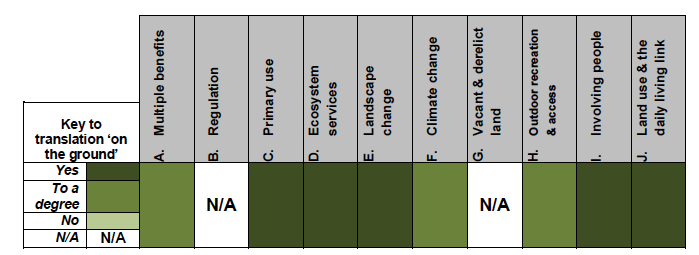
3.41 The two LUS Principles deemed to be non-applicable in the CALL context are Principle B on regulation and G on vacant and derelict land. In terms of Principle B, the only route that would be available to the CALL case study is route No.3 - i.e. doing something different or new that somehow streamlines or supports the delivery of existing regulation (see paragraph 3.10) though this did not come across in the data or the evaluation and is considered to be a marginal issue for CALL. In terms of Principle G, vacant and derelict land is not a significant land management issue within the CALL project area and it is therefore not considered in any of the Partnership's activities.
3.42 LUS Principle C on primary use, D on ecosystem services, E on landscape change, I on involving people and J on land use and the daily living link were all considered to have been translated fully. In relation to LUS Principle D for example, the CALL Programme Plan is framed within an ecosystems approach including specific mention to the Convention on Biological Diversity ecosystems approach principles[13] (CBD) and Scottish Wildlife Trust's (SWT) Living Landscapes Policy[14] (SWT, 2009). There is a particular focus on key ecosystem processes/intermediate services through consideration of modelled integrated habitat networks (IHNs) data. This is carried through from the strategic Programme Plan level to the project level in the CALL partnership's habitat connections opportunity mapping work. The opportunities mapping work also considers key ecosystem services including climate regulation (carbon storage through deep peat/carbon rich soils), environmental settings (landscapes) and food production (crofting on the coastal margins).
3.43 Of the three LUS Principles that have only been considered to a degree, Principle F on climate change stands out. Although the CALL case study has considered climate change mitigation and adaptation, the focus of CALL's adaptation agenda is on ecological connectivity and ecosystem resilience as opposed to other relevant adaptation issues (e.g. protection against storms and extreme weather) and this is why CALL has been assessed as having translated this Principle only 'to a degree'.
Dee Catchment Partnership Business Plan
3.44 As outlined at Table 2.4, 'on the ground' in the context of the Dee Catchment Partnership (DCP) has been interpreted as: the process of identifying priorities and making decisions by the Partnership to inform the development of the Business Plan i.e. the degree to which and how the LUS Principles are translated in the priorities, decisions and provisions within the Business Plan.
3.45 The DCP 'on the ground' decision-making juncture has been met during the course of the LUS Delivery Evaluation Project and has been considered fully in the Research Question No.1 evaluation. More detailed information on the DCP 'on the ground' decision-making juncture is provided at Appendix 4 (paragraph 4.24 onwards) along with the detailed evaluation which includes an explanation of the rationale for each assessment. Figure 3.7 provides a summary of the Research Question No.1 evaluation for the DCP case study.
3.46 Four of the LUS Principles have been translated fully, five to a degree and one has not been translated at all. Accordingly, all ten Principles are considered to be relevant to the DCP case study. The DCP Business Plan 2013-2016 includes three specific mentions of the LUS (including reference to the Aberdeenshire Regional Land Use Framework pilot[15] which overlaps with the DCP project area) though there is no explicit mention of individual LUS Principles. Accordingly, all consideration of the Principles is implicit rather than explicit.
3.47 LUS Principle A on multiple benefits, D on ecosystem services, H on outdoor recreation and access and I on involving people were all considered to have been translated fully. In terms of Principle A for example, the purpose of the DCP is to align and deliver the objectives of a substantial number of partner organisations with wide remits. In this regard, projects that demonstrate multiple benefits are prioritised as they are likely to improve value for money and reflect the objectives of several partners. Similarly, LUS Principle H type issues are reflected in several of the partner organisations objectives and there is a drive within the DCP to work to reduce conflicts between outdoor recreation and access and other land management issues.
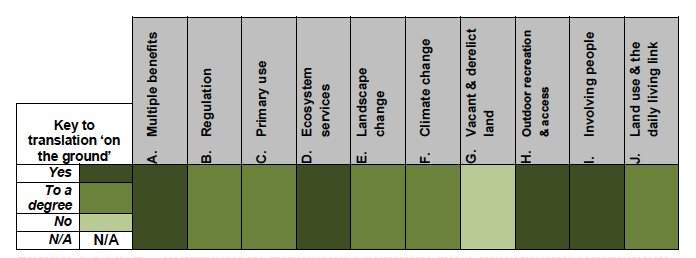
Figure 3.7 DCP - summary of Research Question No.1 evaluation: translation of LUS Principles into decision-making 'on the ground'
3.48 In terms of LUS Principles that have been translated to a degree, LUS Principle B on regulation is noteworthy as it translates the Principle via route No.4 (see paragraph 3.10). In this regard, although the DCP is not a public body as such many of the DCP partners are public bodies and there is an emphasis within the DCP on integrating the delivery of regulatory objectives e.g. the Water Framework Directive[16] (WFD), Habitats Directive[17], Floods Directive[18] and National Parks (Scotland) Act 2000[19].
3.49 LUS Principle G on vacant and derelict land (VDL) is considered to have not been translated. Although there is understood to be some VDL within the Dee catchment there is no explicit or implicit reference to LUS Principle G within the Business Plan. VDL is arguably an issue of possible significance given its potential role providing multiple benefits e.g. the potential flood storage function of VDL sites where they are located within the floodplain.
Glasgow City Council Local Development Plan (LDP)
3.50 As outlined at Table 2.4, 'on the ground' in the context of the Glasgow Local Development Plan (LDP) case study has been interpreted as: the process of developing and adopting Glasgow LDP Supplementary Guidance i.e. the degree to which and how the LUS Principles are translated into provisions within the Supplementary Guidance. Due to the broad scope of the LDP, the evaluation has focussed on a specific key regeneration issue/option within the LDP (environment) and specific supplementary guidance (green network).
3.51 The Glasgow LDP 'on the ground' decision-making juncture has not been met during the course of the LUS Delivery Evaluation Project. As such, the Research Question No.1 evaluation has considered process issues only i.e. the degree to which the LUS Principles are considered within the LDP Main Issues Report (MIR). More detailed information on the Glasgow LDP 'on the ground' decision-making juncture is provided at Appendix 4 (paragraph 4.35 onwards) along with the detailed evaluation which includes an explanation of the rationale for each assessment. Figure 3.8 provides a summary of the Research Question No.1 evaluation for the Glasgow LDP case study.
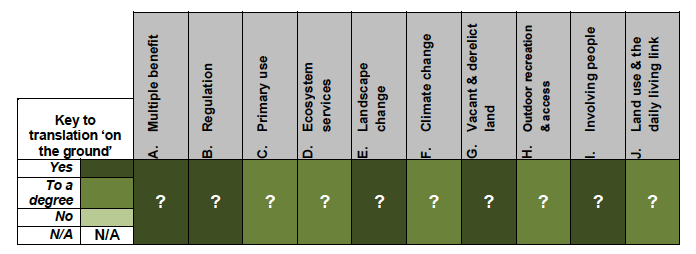
Figure 3.8 Glasgow LDP - summary of Research Question No.1 evaluation: translation of LUS Principles into decision-making 'on the ground'
- The Glasgow LDP case study did not reach its specific 'on the ground' decision-making juncture during the lifetime of the LUS Delivery Evaluation Project
- As such, the summary in the Figure above is based on the evaluation of process issue data only, hence why all assessments are caveated with a question mark
3.52 Recognising that the Research Question No.1 evaluation of the Glasgow LDP case study is an estimate based on process issues data only, five of the LUS Principles have been translated fully and five to a degree. Accordingly, all ten Principles are considered to be relevant to the Glasgow LDP case study. There is no explicit mention of the LUS or the LUS Principles so all consideration of the Principles is implicit rather than explicit.
3.53 LUS Principle A on multiple benefits, B on regulation, E on landscape change, G on vacant and derelict land and I on involving people are all considered to have been translated fully (in terms of process issues - see paragraph 3.5 for further information). In terms of Principle E for example, the MIR includes implicit recognition of undertaking landscape planning/ management at different scales. Specific landscape studies have informed the issues outlined in the MIR including the relevant Landscape Character Assessment (LCA) and a 2004 landscape capacity study undertaken to inform energy development. There is also a specific SEA objective on landscape - "to protect and enhance landscape character, distinctiveness and scenic value" (GCC, 2011b) - meaning, therefore, that LUS Principle E type issues have been considered within the SEA process.
3.54 The Glasgow LDP case study's consideration of LUS Principle G and I is also noteworthy. In terms of LUS Principle G, the MIR includes extensive consideration of the VDL resource within the city and its potential utility providing a range of benefits and functions across issues such as housing, energy, recreation, wellbeing and community growing, including through the Council's award winning Stalled Spaces[20] initiative which facilitates temporary use agreements between developers/landowners and community groups. In terms of LUS Principle I, stakeholder and wider public consultation has been facilitated, in part, through the SEA process but the Council also used several innovative techniques to engage stakeholders and communities including a postcard consultation on the MIR's key issues[21].
Forestry and Woodland Strategies
3.55 As outlined at Table 2.4, 'on the ground' in the context of the Forestry and Woodland Strategy (FWS) case study has been interpreted as: the process of developing the FWS i.e. the degree to which the LUS Principles have been considered in FWS development process and SEA and then translated into key provisions within the adopted FWS. The FWS case study has drawn on two example FWS: 1) the joint Stirling and Clackmannanshire FWS; and 2) the Perth and Kinross FWS[22].
3.56 The FWS 'on the ground' decision-making juncture has not been met during the course of the LUS Delivery Evaluation Project. As such, the Research Question No.1 evaluation has only considered process issues i.e. the degree to which the LUS Principles are considered within the FCS Right Tree in the Right Place (RTRP) Guidance (FCS, 2010), in the draft FWS themselves and in related SEA and Habitats Regulation Assessment (HRA) reports. More detailed information on the FWS 'on the ground' decision-making juncture is provided at Appendix 4 (paragraph 4.42 onwards) along with the detailed evaluation which includes an explanation of the rationale for each assessment. Figure 3.9 provides a summary of the Research Question No.1 evaluation for the FWS study.
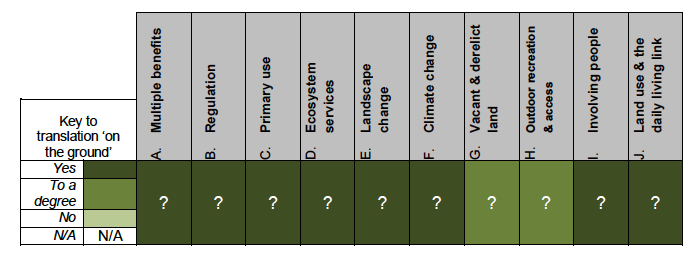
Figure 3.9 Forestry and Woodland Strategies - summary of Research Question No.1 evaluation: translation of LUS Principles into decision-making 'on the ground'
- The two FWS case studies did not reach their specific 'on the ground' decision-making juncture during the lifetime of the LUS Delivery Evaluation Project
- As such, the summary in the Figure above is based on the evaluation of process issue data only hence why all assessments are caveated with a question mark
3.57 Recognising that the Research Question No.1 evaluation of the FWS case studies is an estimate based on process issues data only, eight of the LUS Principles have been translated fully and two to a degree. Accordingly, all ten Principles are considered to be relevant to the FWS case studies. There is no explicit mention of the LUS or the LUS Principles within the RTRP Guidance (which predates the LUS). The LUS is mentioned in both draft FWS and in their accompanying SEA reports although specific LUS Principles are not mentioned. As such, all consideration of the Principles is implicit rather than explicit.
3.58 All LUS Principles apart from Principle G on vacant and derelict land (VDL) and H on outdoor recreation and access have been translated fully (in terms of process issues). In the case of Principle A on multiple benefits and C on primary use for example, there is a particular emphasis on the use of spatial data and spatial analysis, facilitated through the use of geographic information systems (GIS), to identify constraints on (i.e. areas of primary land use where forestry development is likely to be less appropriate) and opportunities for the delivery of multifunctional forestry. Key multiple benefits identified through the spatial analysis approach include water and flood risk management, ecological connectivity (forest habitat networks), health and wellbeing/community development and biodiversity (ancient woodlands). Key constraints/areas of primary land use identified include designated natural and cultural heritage sites, areas of wild land character, peat/carbon rich soils and high value agricultural land.
3.59 In terms of the two LUS Principles that have been translated less well, Principle G on vacant and derelict land (VDL) was treated less comprehensively within RTRP with only two of the twenty one provisions assessed referencing VDL - e.g. "improving vacant, derelict and underused land" (FCS, 2010 p.14) is identified as a specific role for FWS and the "creation of woodland on former extraction and industrial sites to contribute to both habitat networks and green networks" (FCS, 2010 p.52) is highlighted as a specific objective that may be pursued. Crucially the two FWS case studies both include minor reference to LUS Principle G type issues though there is no specific assessment of the VDL resource within a forestry context or specific recommendations or policies to target forestry development in this regard.
3.60 Principle H on outdoor recreation and access is also translated less well. Although there is some consideration of a range of outdoor recreation activities within the FWS case studies, this theme is much less prevalent in the spatial analysis. As such, there is a potential risk that this objective/ecosystem service of woodland management may lose out in the face of others that have been more integral to the spatial analysis approach e.g. water/flood risk management, ecological connectivity etc.
Loch Lomond and Trossachs National Park Partnership Plan (NPPP)
3.61 As outlined at Table 2.4, 'on the ground' in the context of the Loch Lomond and the Trossachs National Park (LLTNP) National Park Partnership Plan (NPPP) case study has been interpreted as: the process of developing and agreeing the NPPP Individual Partner Agreements (IPAs) i.e. the degree to which and how the LUS Principles are translated into specific actions and provisions within the IPAs.
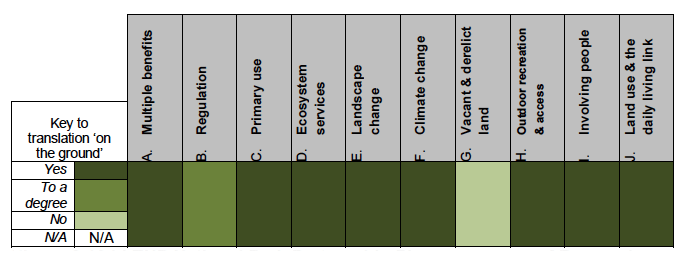
Figure 3.10 LLTNP National Park Partnership Plan - summary of Research Question No.1 evaluation: translation of LUS Principles into decision-making 'on the ground'
3.62 The LLTNP 'on the ground' decision-making juncture has been met during the course of the LUS Delivery Evaluation Project and has been considered fully in the Research Question No.1 evaluation. More detailed information on the LLTNP 'on the ground' decision-making juncture is provided at Appendix 4 (paragraph 4.49 onwards) along with the detailed evaluation which includes an explanation of the rationale for each assessment. Figure 3.10 provides a summary of the Research Question No.1 evaluation for the LLTNP case study.
3.63 Seven of the LUS Principles have been translated fully, one to a degree and one hasn't been translated at all. Accordingly, all ten Principles are considered to be relevant to the LLTNP case study. The NPPP includes two specific mentions of the LUS in relation to the NPPP's conservation and rural development policy. Despite this there is no explicit mention of individual LUS Principles so all consideration of the Principles is implicit rather than explicit.
3.64 The NPPP is felt to have translated LUS Principle B on regulation to a degree. The NPPP includes a priority for action to engage with the development of the Scotland Rural Development Programme (SRDP) for 2014-2020[23] including the "promotion of the National Park as a priority area within the new SRDP" to ensure that "the National Park [has] an [SRDP] scheme that is responsive to local needs and that delivers park and national outcomes" (LLTNPA, 2012 p.20). In this regard, the NPPP has the potential to support the translation of LUS Principle B via route No.4 (see paragraph 3.10 for further information) though the impact of the Authority's negotiations on the SRDP 2014-2020 remain to be seen.
3.65 LUS Principle G on VDL is considered to not have been translated at all. There is no consideration of LUS Principle G type issues within the NPPP although VDL is a significant issue in West Dunbartonshire[24], which, in part, falls within the boundaries of the National Park. Urban areas in West Dunbartonshire just adjacent to the park's southern boundary, such as Alexandria and Dumbarton, contain significant VDL sites which could potentially raise both opportunities and constraints for key transboundary land use/management issues in the park e.g. landscape planning, ecological networks, natural flood management etc.
3.66 As shown on Figure 3.10 all other LUS Principles have been translated fully by the NPPP case study. This is unsurprising given the nature of the NPPP, the objectives of National Parks[25] and indeed the fact that the LUS is referenced as one of the key national level strategies providing the context for the NPPP. Also, the Authority highlight how the NPPP itself is the "high-level land use strategy for the National Park" (LLTNPA, 2012 p.13), exemplifying the importance of sustainable land use principles informing the scope of its policies and actions. Appendix 4 has more detailed information on how the NPPP has successfully translated LUS Principles A, C, D, E, F, H, I and J into decision-making 'on the ground'.
Monitor Farms Programme
3.67 As outlined at Table 2.4, 'on the ground' in the context of the Monitor Farms case study has been interpreted as: the appointment of specific monitor farms i.e. the degree to which and how the LUS Principles are incorporated and translated through the land management actions and approaches being tested and considered on specific monitor farms.
3.68 The Monitor Farms 'on the ground' decision-making juncture has been met during the course of the LUS Delivery Evaluation Project and has been considered fully in the Research Question No.1 evaluation. More detailed information on the Monitor Farms 'on the ground' decision-making juncture is provided at Appendix 4 (paragraph 4.53 onwards) along with the detailed evaluation which includes an explanation of the rationale for each assessment. Figure 3.11 provides a summary of the Research Question No.1 evaluation for the Monitor Farms case study.
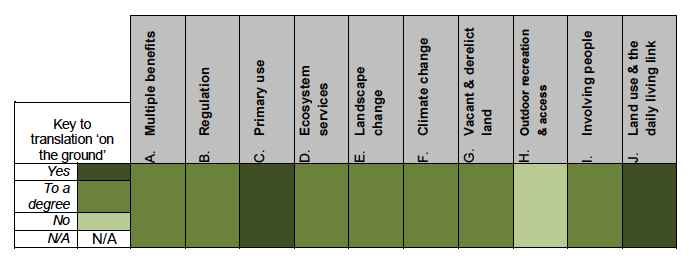
Figure 3.11 Monitor Farms - summary of Research Question No.1 evaluation: translation of LUS Principles into decision-making 'on the ground'
3.69 Two of the LUS Principles have been translated fully, seven to a degree and one has not been translated at all. Accordingly, all ten Principles are considered to be relevant to the Monitor Farms case study. However, there is no explicit mention of the LUS or the LUS Principles within the Monitor Farms Strategy (which predates the LUS). As such, all consideration of the Principles is implicit rather than explicit.
3.70 Of all eleven case studies Monitor Farms is arguably the most different in terms of its inherent focus on production related land management objectives. Most (if not all) of the other case studies have some focus (to a greater or lesser degree) on conservation management. As such, it is unsurprising that the Monitor Farms case study has translated certain LUS Principles less comprehensively. Key Principles in this regard include Principle A on multiple benefits (i.e. the focus of the case study is on production rather than wider multiple benefits), D on ecosystem services, E on landscape change and H on outdoor recreation and access. In essence, if a given land management activity doesn't have a commercial focus it is less likely to be considered within the activities of the Monitor Farms programme.
3.71 The corollary of this of course is that the more production/employment related LUS Principles have been translated fully. LUS Principle C on primary use has been translated fully, especially as farms are managed on an understanding of which areas are most appropriate for specific farming practices and areas. Principle J on land use and the daily living link has also been translated fully not least as the programme as a whole is intended to boost the competitiveness of the livestock sector.
3.72 LUS Principle H on outdoor recreation and access is considered to have not been translated at all. Whilst it is acknowledged that Principle H type issues are not a priority of the programme, there is considered to be significant scope for diversification in some areas into non-productive revenue streams (e.g. rural tourism activities, food processing and marketing etc).
North Harris Trust
3.73 As outlined at Table 2.4, 'on the ground' in the context of the North Harris Trust (NHT) case study has been interpreted as: the decision-making process adopted by the North Harris Trust i.e. the degree to which and how the LUS Principles are considered when relevant decisions are made and then translated through subsequent action.
3.74 The NHT 'on the ground' decision-making juncture has been met during the course of the LUS Delivery Evaluation Project and has been considered fully in the Research Question No.1 evaluation. More detailed information on the NHT 'on the ground' decision-making juncture is provided at Appendix 4 (paragraph 4.66 onwards) along with the detailed evaluation which includes an explanation of the rationale for each assessment. Figure 3.12 provides a summary of the Research Question No.1 evaluation for the NHT case study.
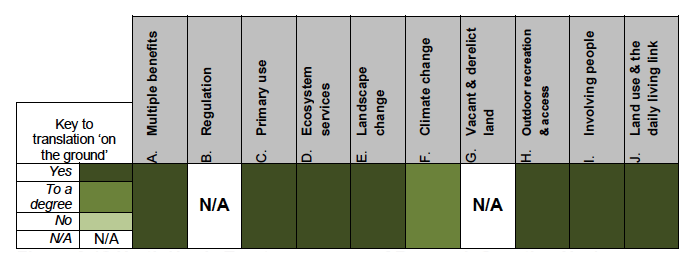
Figure 3.12 North Harris Trust - summary of Research Question No.1 evaluation: translation of LUS Principles into decision-making 'on the ground'
3.75 Seven of the LUS Principles have been translated fully, one to a degree and two Principles are deemed to be non-applicable to the specific context. Accordingly, only eight of the LUS Principles are considered to be relevant to the NHT case study. However, there is no explicit mention of the LUS or the LUS Principles within the NHT case study materials reviewed as part of this research. As such, all consideration of the Principles is implicit rather than explicit. Consideration of the LUS and its Principles is being driven by the NHT Land Manager who has a background in agricultural policy as well as practical land management.
3.76 In common with other case studies (Buccleuch Estates and CALL) LUS Principle B on regulation and G on VDL are considered to be non-applicable to NHT's specific context. In terms of Principle B, none of the four translation routes are relevant in this context, apart from route No.3 perhaps (see paragraph 3.10 for further information) but this did not come across in the data or the evaluation. In terms of Principle G, the Trust publishes details of vacant crofts on their website but beyond this, VDL is not considered to be a significant issue on the island.
3.77 LUS Principle F on climate change has only been translated to a degree. The Trust consider climate change mitigation objectives in a range of their activities including raising awareness of damaging land management activities (e.g. peat cutting, muirburn etc), renewable energy development and community/household energy conservation projects (though this is less relevant to land use/management and the LUS). Crucially however, within the scope of the data and the evaluation, there is no clear consideration of climate change impacts or adaptation measures, hence why Principle F is only considered to have been translated to a degree.
3.78 Conversely, the remaining seven LUS Principles have all been translated fully. For example, given the nature of the project - i.e. the Trust manages one of the largest community owned estates in Scotland on behalf of its members - it is unsurprising that LUS Principle I on involving people and J on land use and the daily living link have been translated fully. In terms of Principle I, the Trust runs comprehensive public consultations for any proposals that is likely to be contentious. Other decisions and proposals are discussed in Board meetings which are open to all members of the Trust[26]. Where there is dispute over the Trust's activities, the Trust endeavours to hold one on one meetings with the concerned party to better understand the nature of their concerns and to explain proposals in more detail - in essence there is a process of dialogue to try and resolve issues. In terms of Principle J, the Trust works closely with schools to try and ensure that traditional land management skills are retained within the younger generation. Also, efforts are made to highlight the importance and potential of land based employment opportunities.
Galloway and Southern Ayrshire Biosphere
3.79 As outlined at Table 2.4, 'on the ground' in the context of the Galloway and Southern Ayrshire Biosphere (the Biosphere) case study has been interpreted as: the scoping, development and subsequent implementation of actions emerging from the Biosphere Theme Groups i.e. the degree to which and how the LUS Principles are considered in Theme Group discussions and then translated through subsequent action. The research has focussed specifically on the Biosphere's getting the best from the land[27] Theme Group.
3.80 The Biosphere 'on the ground' decision-making juncture has been met in part during the course of the LUS Delivery Evaluation Project and has been considered as fully as possible in the Research Question No.1 evaluation. More detailed information on the Biosphere 'on the ground' decision-making juncture (and the degree to which this has been met during the course of this project) is provided at Appendix 4 (paragraph 4.72 onwards) along with the detailed evaluation which includes an explanation of the rationale for each assessment. Figure 3.13 provides a summary of the Research Question No.1 evaluation for the Biosphere case study.
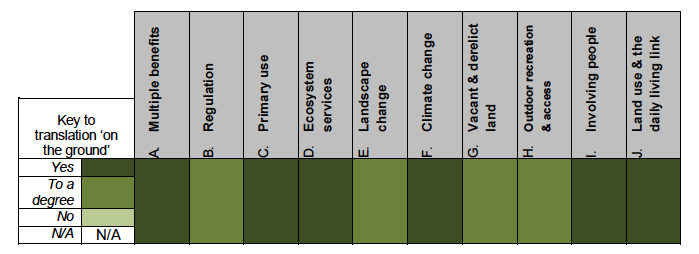
Figure 3.13 Galloway and Southern Ayrshire Biosphere - summary of Research Question No.1 evaluation: translation of LUS Principles into decision-making 'on the ground'
3.81 Six of the LUS Principles have been translated fully and four to a degree. Accordingly, all ten of the LUS Principles are considered to be relevant to the Biosphere case study. As outlined further at Appendix 4, the focus of the Biosphere evaluation has been on the getting the best from the land Theme Group and the Biosphere Partnership's catchment scale stakeholder engagement approach to integrated land/water management planning in particular. This approach is very much based on the LUS and the literature on the approach includes explicit mention of the LUS and Scotland's climate change legislation. There is also implicit reference to key LUS Principles including Principle A on multiple benefits, C on primary use, D on ecosystem services, E on landscape change, F on climate change and I on involving people. Despite this, the wider consideration of LUS Principles elsewhere in the approach is more focussed on LUS Principle type issues (as opposed to the Principles themselves) and, as such, all consideration of the Principles is implicit rather than explicit.
3.82 The nature of the Biosphere Partnership's catchment scale stakeholder engagement approach is such that many of the LUS Principles have been considered fully. For example the approach's extensive use of catchment scale spatial data and spatial analysis and the inclusive, bottom-up approach to stakeholder engagement (including engagement with affected communities and individual land owners/farmers) is such that LUS Principles A, C and I have been considered fully. In particular, spatial data is a key input to integrated land use/management constraints and opportunities mapping which forms the basis of discussion between the various stakeholders.
3.83 Conversely, LUS Principle B on regulation, E on landscape change, G on VDL and H on outdoor recreation and access have only been considered to a degree. In terms of Principle G for example, whilst there is some reference to VDL issues within the materials reviewed - e.g. the "legacy of industrial dereliction" (Biosphere Partnership, 2012 p.9), there is no specific discussion or reference to how VDL sites might be utilised or an assessment of the area's VDL resource. As regards Principle E, whilst there are key strengths to the approach (e.g. the consideration of multiple scales from whole catchments to the site/field scale) there is no mention of specific tools or guidance that can be used to support landscape planning and management (e.g. Landscape Character Assessment) though underlying biophysical processes/features are considered (e.g. the relationship between geology, soils, land use/management and, ultimately, landscape).
Wildlife Estates Scotland
3.84 As outlined at Table 2.4, 'on the ground' in the context of the Wildlife Estates Scotland (WES) case study has been interpreted as: the application and development of the WES accreditation process i.e. the degree to which and how the LUS Principles have been translated within the WES accreditation criteria/process and in decisions to approve the accreditation of applicant estates.
3.85 The WES 'on the ground' decision-making juncture has been met during the course of the LUS Delivery Evaluation Project and has been considered fully in the Research Question No.1 evaluation. More detailed information on the WES 'on the ground' decision-making juncture is provided at Appendix 4 (paragraph 4.80 onwards) along with the detailed evaluation which includes an explanation of the rationale for each assessment. Figure 3.14 provides a summary of the Research Question No.1 evaluation for the WES case study.
3.86 Five of the LUS Principles have been translated fully, four to a degree and one Principle is deemed to be non-applicable to the specific context. Accordingly, only nine of the LUS Principles are considered to be relevant to the WES case study. Key WES documentation includes explicit reference to the LUS though there is no explicit reference to individual LUS Principles. As such, all consideration of the Principles is implicit rather than explicit.
3.87 LUS Principle G on VDL is deemed to be non-applicable in this case. LUS Principle G type issues are not discussed within the accreditation paperwork and VDL is not felt to be a relevant issue for estate management in Scotland. Despite this, it may be the case, for example, that mineral extraction is a management objective on some estates. Where this is the case LUS Principle G may be more relevant though this wasn't apparent from the data or the evaluation.
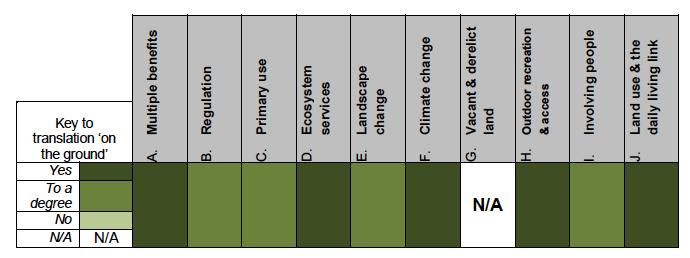
Figure 3.14 Wildlife Estates Scotland (WES) - summary of Research Question No.1 evaluation: translation of LUS Principles into decision-making 'on the ground'
3.88 LUS Principle A on multiple benefits, D on ecosystem services, F on climate change, H on outdoor recreation and access and J on land use and the daily living link have all been translated fully by the WES case study. Given the nature of the accreditation scheme it is unsurprising that Principle D has been translated fully. In particular, the concepts and language of ecosystem services and the ecosystems approach has been considered throughout the application form/as part of the general rationale for WES and certain land uses and habitats are framed in terms of benefits. In WES' case Principle F has been translated fully as the accreditation scheme considers both the mitigation and adaptation agendas - e.g. the carbon storage benefits of certain land management practices are discussed as are actions to reduce flood risk (i.e. an adaptation measure) such as river and floodplain restoration.
3.89 Of the LUS Principles that have only been translated to a degree, Principle E on landscape change and I on involving people perhaps stand out more than others due to the nature of the WES accreditation scheme. In terms of Principle E, the application form discusses specific landscape features and types of landscapes (e.g. farm and forest landscapes) though there is no specific treatment of landscape planning/management at different scales or reference to the use of specific tools to support landscape planning (e.g. the use of Landscape Character Assessment data or input from environmental assessment processes for major land use/management changes). In terms of Principle I, there is consideration within the accreditation process of the extent to which estates are connected to and contribute to local communities though this is less about involving people in decision-making per se and more about the estate's contribution to the local economy.
Summary of key themes/issues identified
3.90 Each case study considered in the LUS Delivery Evaluation Project has been evaluated in terms of Research Question No.1 - i.e. "have the high level LUS Principles been (implicitly or explicitly) translated into decision-making on the ground? And if they have, how well?" To facilitate this evaluation, a specific 'on the ground' decision-making juncture has been defined for each case study as described in Chapter 2 (see Table 2.4 and paragraph 2.28 onwards). The sub-sections above provide a summary of the Research Question No.1 evaluation and detailed evaluation tables are provided at Appendix 4.
3.91 In terms of the relevance of the LUS Principles to the eleven case study land use delivery mechanisms, there were only a small handful of instances (when looking across the whole Research Question No.1 data set - see Figure 3.4) where an LUS Principle was considered not relevant in a given decision-making context. Additionally, this only applied to LUS Principle B on regulation and Principle G on vacant and derelict land. Further information on LUS Principle relevance is provided at paragraph 3.14 onwards.
3.92 As discussed extensively in the methodology Chapter (see paragraph 2.28 onwards), within the scope of this project, it has not been possible to consider case study decision-making processes that have resulted in practical action causing a tangible impact in terms of land use/management activity in the landscape (e.g. forest harvesting/planting, foot path maintenance, livestock density etc). Instead, the research defined case study specific decision-making junctures that have been construed as decision-making 'on the ground' for the purposes of the evaluation (see Table 2.4).
3.93 In this regard, there is evidence of LUS Principles having been translated 'on the ground' across all case studies and all Principles. Indeed the Principles were considered to have been translated 'fully' in more than half (57 out of 110) of the instances (i.e. when looking across the whole Research Question No.1 data set - see Figure 3.4) assessed and 'to a degree' in 42 out of 110 instances.
3.94 As a key overall finding therefore, it is important to highlight that the LUS Principles have been translated at least 'to a degree' in 99 of the 110 instances assessed. As such, this finding suggests that on the basis of the eleven case study land use delivery mechanisms considered, there may already be significant capacity to deliver sustainable land use, as per the requirements of the LUS, within Scotland's existing land use delivery landscape. There is, however, clearly still 'room for improvement' as LUS Principles were translated fully in only 57 of 110 instances (see paragraph 3.16). Also, it is crucial to stress that this finding is illustrative of land use delivery in Scotland (as opposed to definitive) as the research findings are based on a non-statistically significant sample of case study land use delivery mechanisms.
3.95 As is evident on Figures 3.2 and 3.4 there were also a number of LUS Principles that were translated less well by the case studies. This is largely a function of the evaluation criteria used (see Appendix 1) and the way in which the criteria were imposed on the case studies i.e. the criteria are quite onerous and where case studies didn't meet the criteria they were considered to have not translated the Principle into decision-making 'on the ground' (see paragraph 3.3 onwards). In particular, LUS Principle B on regulation, F on climate change, G on vacant and derelict land and H on outdoor recreation and access were only translated to a degree by at least five of the eleven case studies.
3.96 The specific case of Principle F is discussed at paragraphs 3.21 and 3.22. Principle B was translated less well by a number of case studies as, although some efforts had been made to help streamline or support the delivery of existing regulation, the approaches used were either not comprehensive, not proven or both. This issue relates very much to the specific case of LUS Principle B as described at paragraph 3.10 onwards.
3.97 There were issues with the translation of Principle G on vacant and derelict land (VDL) for two main reasons. Firstly, two case studies simply didn't consider VDL even though there is a known VDL resource within the bounds of the study area[28]. Secondly, a number of case studies included reference to VDL but did not consider some of the wider issues captured within the evaluation criteria e.g. an assessment of the VDL resource, designing the regeneration of VDL for the delivery of multiple benefits etc (see Appendix 1).
3.98 There were also issues in terms of Principle H on outdoor recreation and access for a number of reasons especially: 1) inconsistent consideration of LUS Principle H type issues within the framework of policies/projects considered as part of the case study evaluation; 2) the case study had focussed on only a small range of outdoor recreation activities where there was scope to consider more; 3) outdoor recreation and access issues had not been considered on a par with other criteria and has subsequently 'lost out' in integrated land use planning analyses; and 4) LUS Principle H type issues had simply not been considered. This latter issue is particularly significant in Scotland given the outdoor access rights afforded by the Land Reform (Scotland) Act 2003[29].
Contact
Email: Liz Hawkins
There is a problem
Thanks for your feedback